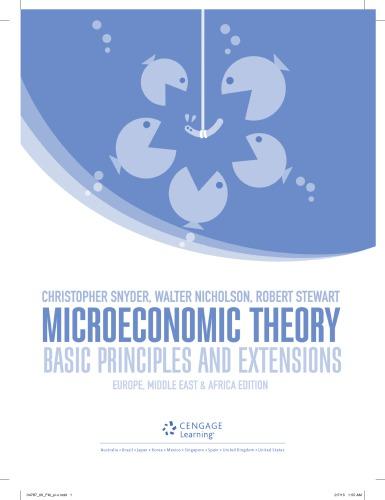7.12 More on the CrrA function For the CRRA utility function (Equation 7.42), we showed that the...
Question:
7.12 More on the CrrA function For the CRRA utility function (Equation 7.42), we showed that the degree of risk aversion is measured by 1 – R. In Chapter 3 we showed that the elasticity of substitution for the same function is given by 1/(1 – R). Hence the measures are reciprocals of each other. Using this result, discuss the following questions.
a.
Why is risk aversion related to an individual’s willingness to substitute wealth between states of the world? What phenomenon is being captured by both concepts?
b.
c.
d.
1 How would you interpret the polar cases R =
1 and R = –∞ in both the risk-aversion and substitution frameworks?
A rise in the price of contingent claims in ‘bad’
times (pb) will induce substitution and income effects into the demands for Wg and Wb. If the individual has a ixed budget to devote to these two goods, how will choices among them be affected?
Why might Wg rise or fall depending on the degree of risk aversion exhibited by the individual?
Suppose that empirical data suggest an individual requires an average return of 0.5 per cent before being tempted to invest in an investment that has a 50–50 chance of gaining or losing 5 per cent.
That is, this person gets the same utility from W0 as from an even bet on 1.055 W0 and 0.955 W0 .
(1) What value of R is consistent with this behaviour?
(2) How much average return would this person require to accept a 50–50 chance of gaining or losing 10 per cent?
Note: This part requires solving nonlinear equa tions, so approximate solutions will suffice. The comparison of the risk–reward trade-off illus trates what is called the equity premium puzzle in that risky investments seem actually to earn much more than is consistent with the degree of risk aversion suggested by other data. See N. R. Kocherlakota, ‘The Equity Premium: It’s Still a Puzzle’, Journal of Economic Literature,
(March 1996): 42–71.
Step by Step Answer:

Microeconomic Theory Basic Principles And Extensions
ISBN: 9781473729483
1st Edition
Authors: Christopher M Snyder, Walter Nicholson, Robert B Stewart






